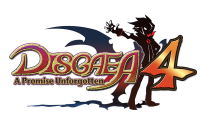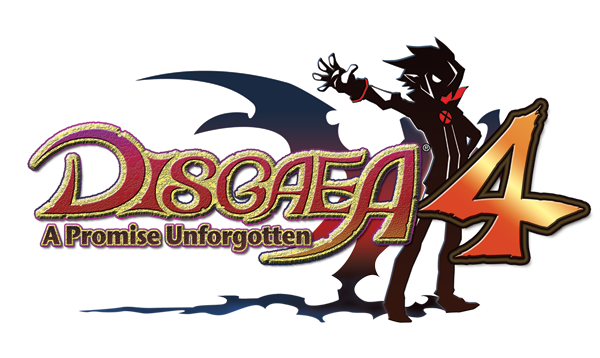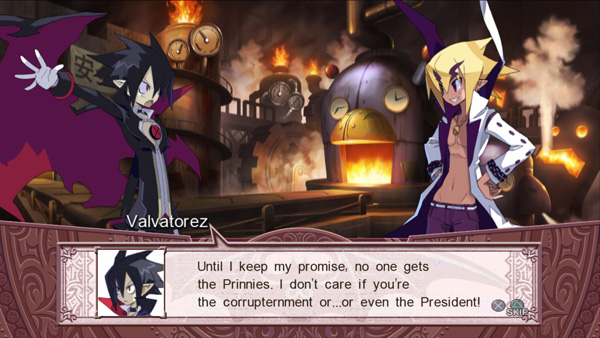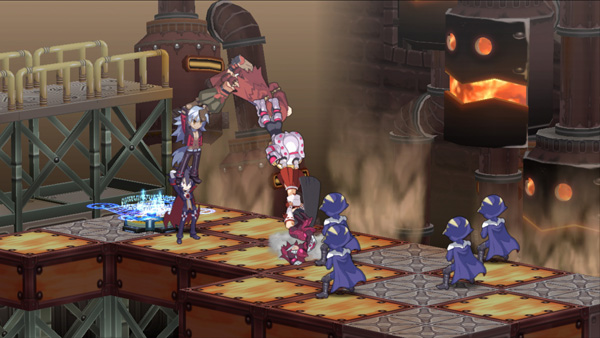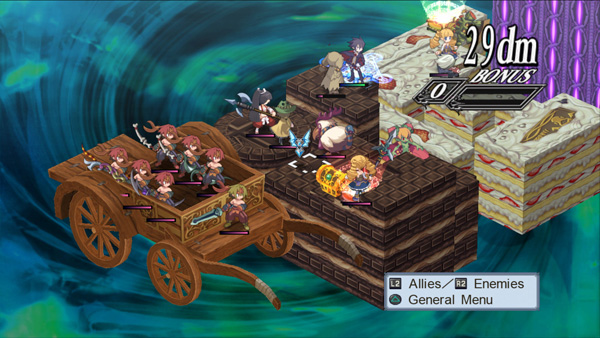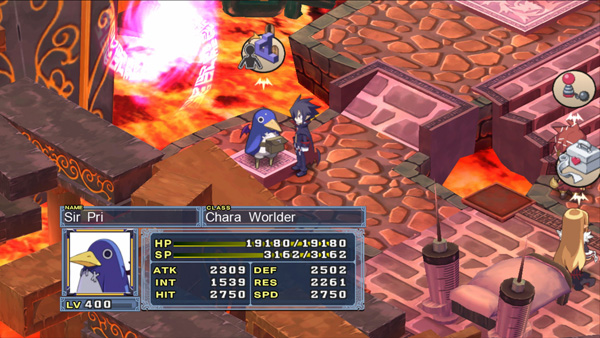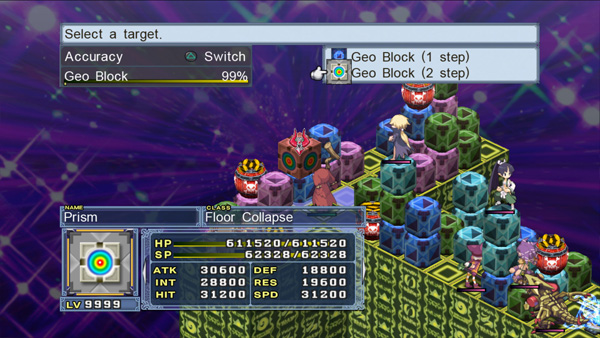NIS America moor the latest in Nippon Ichi Software’s flagship series, Disgaea 4: A Promise Unforgotten, to western harbors. Should you join Team Valvatorez?
Before we plummet into the abyss below, I should make something very clear. I am a Disgaea virgin, completely untarnished by its touch. So approach this review with the knowledge that it’s written by a neophyte who is attempting to appreciate its contours as much as any other first experience with a well-established franchise.
A single word resonates throughout the cambion infested underworld of this one: class. No, not the sophisticated gait of an urbane gentleman. A Promise Unforgotten is defined by class because it stands in irreverent denial of such silly pretentiousness. There’s a universe here whose ventricles are nothing but loony propulsion, a means of spreading the swiving sociopaths native to the setting. It’s a locomotion which makes perfect sense when you’re in Hades. Still, violent demons and atoning for your sins notwithstanding, this molten nether — the hellish sort —is hardly dark or torturous.
Its denizens are wacky, backwards creatures defined by a general disposition toward pell mell. Take your hero, the once feared vampire-tyrant Valvatorez. Thanks to a promise to never again drink human blood, he’s fallen to the title of Prinny Instructor, given the duty of reforming penguin-suited humans whose sins placed them in hell. It’s a job he’s grown proud of, arguably due to acute delusion. Without his sanguinolent nectar, he champions the power of sardines. Often and emphatically, the deranged protagonist will praise them, fight for them or go as far as tangents explaining their branching scientific classification. He is the sifu of sardines.
This serves as the shaky basis for your journey through brimstone. During the latest prinny graduation ceremony, the graduates are whisked off before he can deliver the promised prize: a sardine each. A stalwart defender of his promises, Valvatorez wastes no time setting out to recover the lost souls. This, of course, leads to a mounting list of promises which propel the story down its bouncy, if generally repetitive and shallow, path. Which isn’t to say you’ll find Disgaea 4 without a vault of vim. The characters do well to drive this one along. Extradimensional jackasses, tentacle girls whose highest aspiration is to become the final boss, and faux prinnies anoint the passing battles with charged banter.
Skirmishes take place in a system of augmented strategy RPG convention. There’s the field grid, multifarious classes, and the issues of height, range and maneuverability which all come together as a fundamental basis for domination. Typical elements, there. Disgaea 4 modifies these mechanisms with an array of field effects, ranging from chaotic warp tiles to spaces that reverse, amplify or negate damage. When approaching a veritable checkerboard of these scintillating hazards, positioning is tantamount to victory. And a player cannot approach the obstacle of placement without first learning the art of the throw. In this series, units can be lifted — enemies or allies — and tossed as sacks of grain across the map. This enables a heave to high ground, isolating a pesky samurai on a floating island or, if you lift a string of allied characters, composing a tower. This allows one to execute incredible feats with their cohorts. How can a human-demon tower transform into a living jump rope weapon? There’s no explanation forthcoming. It just happens
The battle system is not without its hiccups. Ranged units will often encounter trouble unleashing a volley or conjuring putrid thaumaturgy at enemies below thanks to questionable height problems. Why can this archer not let loose on a unit five blocks down and three afield when her range is eight? What could be seen as a quibble holds enough might to make the strategist reconsider that otherwise mouth-watering promontory.
If a reviewer were to laud Disgaea 4’s turn-and-attack board for anything, it’d be for the reward it offers. Taking advantage of, and often breaking, the given parameters is something demanded of the schemer. Sometimes, the strangest approach is what finally brings about victory. It’s the freedom of manipulating the battlefield and reveling in the lubricated machinations set forth that leaves one with a sense of accomplishment. Lamentably, this is tempered by a late-game difficulty curve analogous to pushing your lost love off the cliff of no return. A new player, or a player who has not spent excessive time grinding, will hit a very tall, very real wall wherein strategy takes the backseat to luck.
Looming above the meticulously maneuvered operating table as disposable minions brave over-the-top super-dynamic attacks is pleasant for more than the striking eagerness with which units will brave flail and claw for their overlord. Nippon Ichi Software have retained the two-dimensional sprites native to the genre and taken another step in beautifying them. In the place of pixelated projections — which you can opt for by using the classic setting — they’ve fostered striking illustrations that capture the myriad characters well both on and off the battleground.
When the final adversary has been rendered twain by the monster you’re wielding as a blade- oh, right. Demonic allies can also “Magichange” into weapons, supplementing a combatant’s power. Again, when that mess is finished and the subsequent squabbling between foes has been extinguished, players return to their base. This area serves as a nexus for the multitude of activities which take place while your underlings lick their fetid, ochre wounds. There’s the Cam-pain HQ, where you dispatch evil diplomats and erect rancorous symbols of authority, sometimes forbidden love, which have a variety of effects on your characters in combat. Much of what you do there must be legislated by means of the senate, wherein demons must be convinced to support your goal — adopting new character classes, increasing item value, appointing advisors — in order to unlock that particular function.
The second of the two chief locations accessible through the base is the item world. Imagine a dainty homemade kobold spear. Now imagine it stronger, thicker, sharper, radiating plasma. Now imagine diving into that dainty homemade kobold spear’s consciousness, cossetting its crude design and, after ten levels of polish and romance, emerging with Odin’s Javelin. In short, you enter a weapon to empower it by winning battles within the pointy apparatus.
What remains within the base are auxiliary but welcome additions. One can create custom maps, enabled for upload to PSN, if particularly keen on tormenting other players. The creation tool, however, is less than impressive and reminiscent of similar designs released ten years ago. While the nexus itself can be customized in the same manner, it’s hardly warranted given the crippled contraption used for assembly.
Post-game content is worth mentioning, perhaps in a review wholly separate. For the voracious strategist, a cornucopia of additional challenges, characters, classes, epilogues and leveling becomes available after lancing the final boss. Much of it must be unlocked in methods that will remain murky in an effort to avoid spoilers. Suffice it to say: once the chastity belt has fallen, expect another three-four hundred hours of chess.
Altogether, Disgaea 4: A Promise Unforgotten does what it set out to do: impress a niche audience by brewing a tincture of familiarity spiked with a few welcome surprises. NIS aren’t attempting to topple role-playing juggernauts; they know where they’re needed and remain vigilant.
Platform: Playstation 3
Developer: NIS/NIS America
Genre: Strategy Role-Playing Game
Time: 40-50 hours for the main quest. Potentially hundreds thereafter.
Gripes: Murky elevation requirements for ranged units. Difficulty curve is less a curve and more an abrupt strike to the gut.
Get it for the: Addictive, unique strategy and unrelenting wisecracks.
Full Disclosure: PXOD received a review copy of the game.
